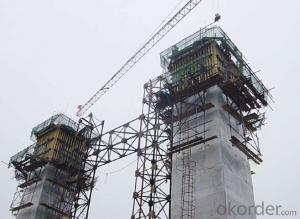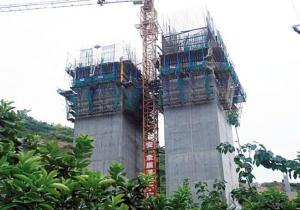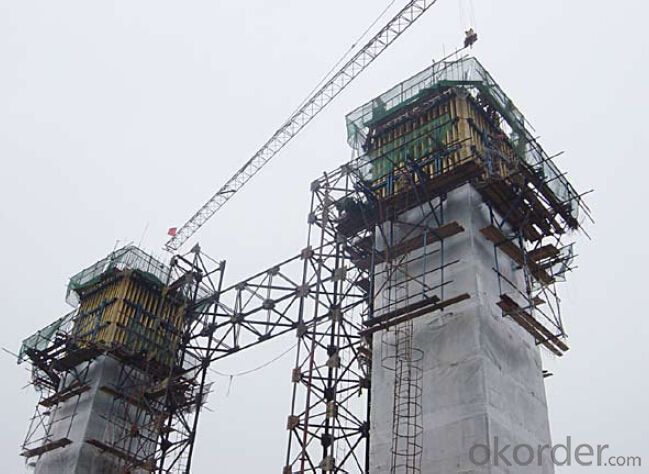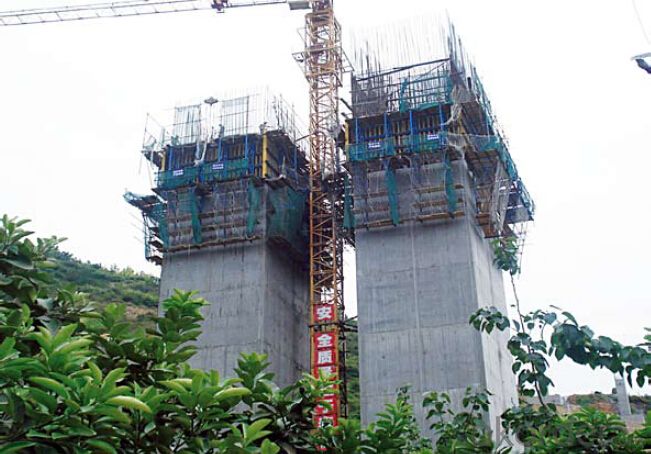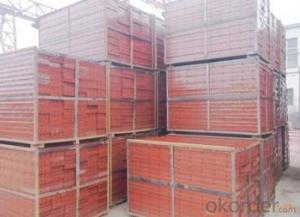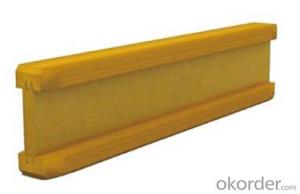Climbing-Bracket for formwork and scaffolding system
- Loading Port:
- Tianjin
- Payment Terms:
- TT OR LC
- Min Order Qty:
- 50 m²
- Supply Capability:
- 1000 m²/month
OKorder Service Pledge
OKorder Financial Service
You Might Also Like
Climbing Bracket CB240 & CB210
They are framework brackets for supporting large-area wall formwork.
Typical applications for the CB240&CB210 are pier and column/shear wall/core walll/ in the
building.
CB210 has smaller size than CB240, it will be cost effective in some condition.
Characteristics:
◆ High bearing capacity
The high loading capacity of the brackets allow very large scaffold units. This saves the number
anchor points required as well as reducing climbing times.
◆ Simple moving procedure by crane
Through the strong connection of formwork together with the climbing scaffold, both can be moved
as a single climbing unit by crane. Thus valuable time-savings can be achieved.
◆ Fast striking process without a crane
With the retrusive set, large formwork elements can also be retracted quickly and a minimum of
effort.
◆ Safe with work platform
The platforms have assembled firmly with bracket and will be climbing together, without scaffolding
but can work safely in spite of your high location.
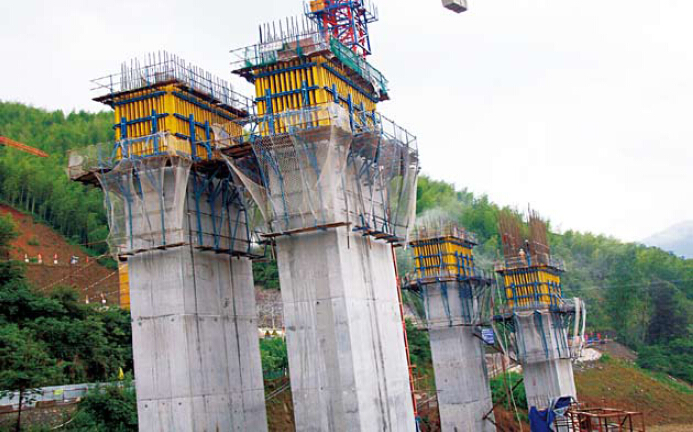
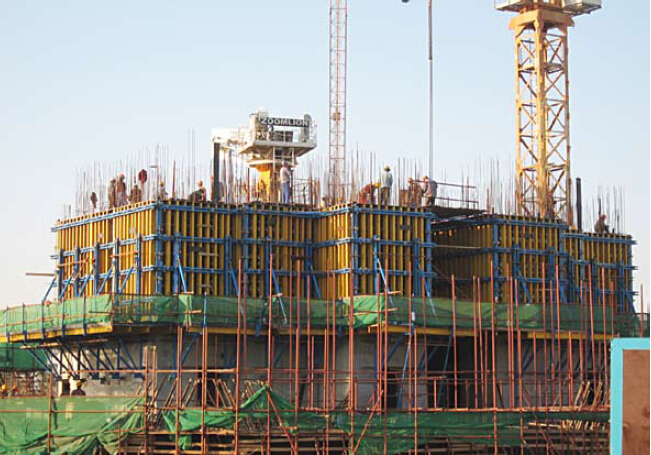
- Q: What are the common types of connections used in steel formwork systems?
- The common types of connections used in steel formwork systems include bolted connections, welded connections, and adjustable connections.
- Q: What are the typical safety precautions when working with steel formwork?
- When working with steel formwork, some typical safety precautions include wearing appropriate personal protective equipment (PPE) such as gloves, safety glasses, and steel-toed boots to protect against potential hazards. Additionally, workers should receive proper training on the proper handling and installation techniques of steel formwork systems. It is essential to ensure that the formwork is securely supported and adequately braced to prevent collapse or accidents. Regular inspection of the formwork for any damages or defects is also crucial to maintain a safe working environment.
- Q: Can steel formwork be used in marine construction projects?
- Yes, steel formwork can be used in marine construction projects. Steel is a durable and strong material that can withstand the harsh conditions of marine environments, such as saltwater, waves, and corrosion. It can be used for various applications in marine construction, including the construction of docks, piers, offshore platforms, and other marine structures. The use of steel formwork ensures a stable and reliable construction process, providing long-lasting and robust structures in marine settings.
- Q: Can steel formwork be used for both new construction and renovation projects?
- Yes, steel formwork can be used for both new construction and renovation projects. Its durability, strength, and versatility make it suitable for various types of construction projects, whether it involves building from scratch or renovating existing structures. Steel formwork provides a sturdy and reusable solution that can be easily adapted to different project requirements, making it a popular choice in the construction industry.
- Q: Can steel formwork be used for both residential and institutional projects?
- Yes, steel formwork can be used for both residential and institutional projects. Its strength and durability make it suitable for various construction projects, including residential buildings and institutional structures. Additionally, steel formwork offers flexibility and ease of use, allowing for efficient construction processes in both residential and institutional settings.
- Q: How does steel formwork handle concrete temperature differentials?
- Steel formwork is a popular choice for concrete construction due to its durability and strength. When it comes to handling concrete temperature differentials, steel formwork offers several advantages. Firstly, steel has a high coefficient of thermal conductivity, meaning it can quickly absorb and distribute heat. This property allows steel formwork to efficiently dissipate the heat generated during the hydration process of concrete. As a result, steel formwork helps to minimize the risk of thermal cracking caused by temperature differentials. Furthermore, steel formwork is known for its dimensional stability. Unlike other materials like wood, steel does not expand or contract significantly with temperature changes. This stability ensures that the formwork maintains its shape and integrity, even when exposed to varying concrete temperatures. It helps to prevent any distortions, warping, or bulging that could affect the quality and appearance of the concrete structure. Additionally, steel formwork is resistant to fire and high temperatures, making it suitable for handling concrete that undergoes rapid temperature changes, such as in hot weather conditions or during the curing process. Its ability to withstand extreme temperatures without deforming or losing its structural integrity ensures that the formwork remains intact and provides the necessary support and containment for the concrete. In summary, steel formwork effectively handles concrete temperature differentials by efficiently dissipating heat, maintaining dimensional stability, and withstanding high temperatures. These properties contribute to the overall quality and durability of the concrete structure, while minimizing the risk of thermal cracking and other issues caused by temperature variations.
- Q: Is steel formwork suitable for projects with high wind loads?
- Yes, steel formwork is suitable for projects with high wind loads. Steel formwork is known for its strength, durability, and stability, making it an ideal choice for construction projects that are subject to high wind loads. Steel formwork provides excellent resistance against wind forces and can withstand strong winds without deformation or damage. Additionally, steel formwork offers a high level of dimensional accuracy, ensuring that the structure can withstand the forces exerted by the wind without compromising its stability. Therefore, steel formwork is a reliable and suitable option for projects with high wind loads.
- Q: What are the considerations when designing steel formwork for elevated walkways?
- There are several important factors to consider when designing steel formwork for elevated walkways. These factors include structural integrity, safety, durability, ease of installation, accessibility, and engaging with experienced professionals. Structural integrity is of utmost importance. The design must be capable of supporting the weight of pedestrians and any additional loads. It should be able to withstand potential deflection or deformation, ensuring a stable walkway. Safety is another key consideration. The formwork should have sufficient handrails and guardrails to prevent falls and create a safe environment. Compliance with safety standards and regulations is crucial to minimize the risk of accidents or injuries. Durability is also essential. The materials used should be able to withstand environmental factors such as weather, temperature changes, and corrosion. Proper surface treatments and coatings can enhance durability, extending the formwork's lifespan and reducing maintenance needs. Efficient and straightforward installation is an important factor to consider. Modular designs or pre-fabricated components can simplify the installation process, minimizing construction time and costs. This ensures consistency in the final structure. Accessibility and inclusivity should be taken into account as well. The design should accommodate individuals with disabilities, providing ramps, handrails, and tactile indicators for equal access. Lastly, it is crucial to involve experienced professionals like structural engineers and architects. Their expertise and knowledge can ensure that all necessary considerations are addressed, resulting in a well-designed and functional steel formwork for elevated walkways.
- Q: Can steel formwork be used for water-retaining structures?
- Yes, steel formwork can be used for water-retaining structures. Steel formwork provides a strong and durable solution for constructing such structures due to its ability to withstand the pressure exerted by the retained water. Additionally, steel formwork can be easily sealed and waterproofed to ensure a watertight construction.
- Q: Can steel formwork be used for both flat and sloped concrete surfaces?
- Yes, steel formwork can be used for both flat and sloped concrete surfaces. Steel formwork is known for its versatility and durability, making it suitable for various types of concrete structures. It can be easily adjusted and shaped to create both flat and sloped surfaces, allowing for the construction of diverse architectural designs. Additionally, steel formwork provides excellent support and stability to the concrete during the pouring and curing process, ensuring a high-quality and uniform finish on both flat and sloped surfaces.
Send your message to us
Climbing-Bracket for formwork and scaffolding system
- Loading Port:
- Tianjin
- Payment Terms:
- TT OR LC
- Min Order Qty:
- 50 m²
- Supply Capability:
- 1000 m²/month
OKorder Service Pledge
OKorder Financial Service
Similar products
Hot products
Hot Searches
